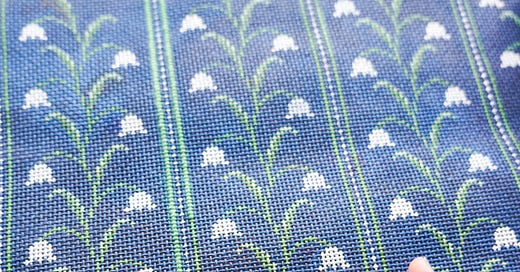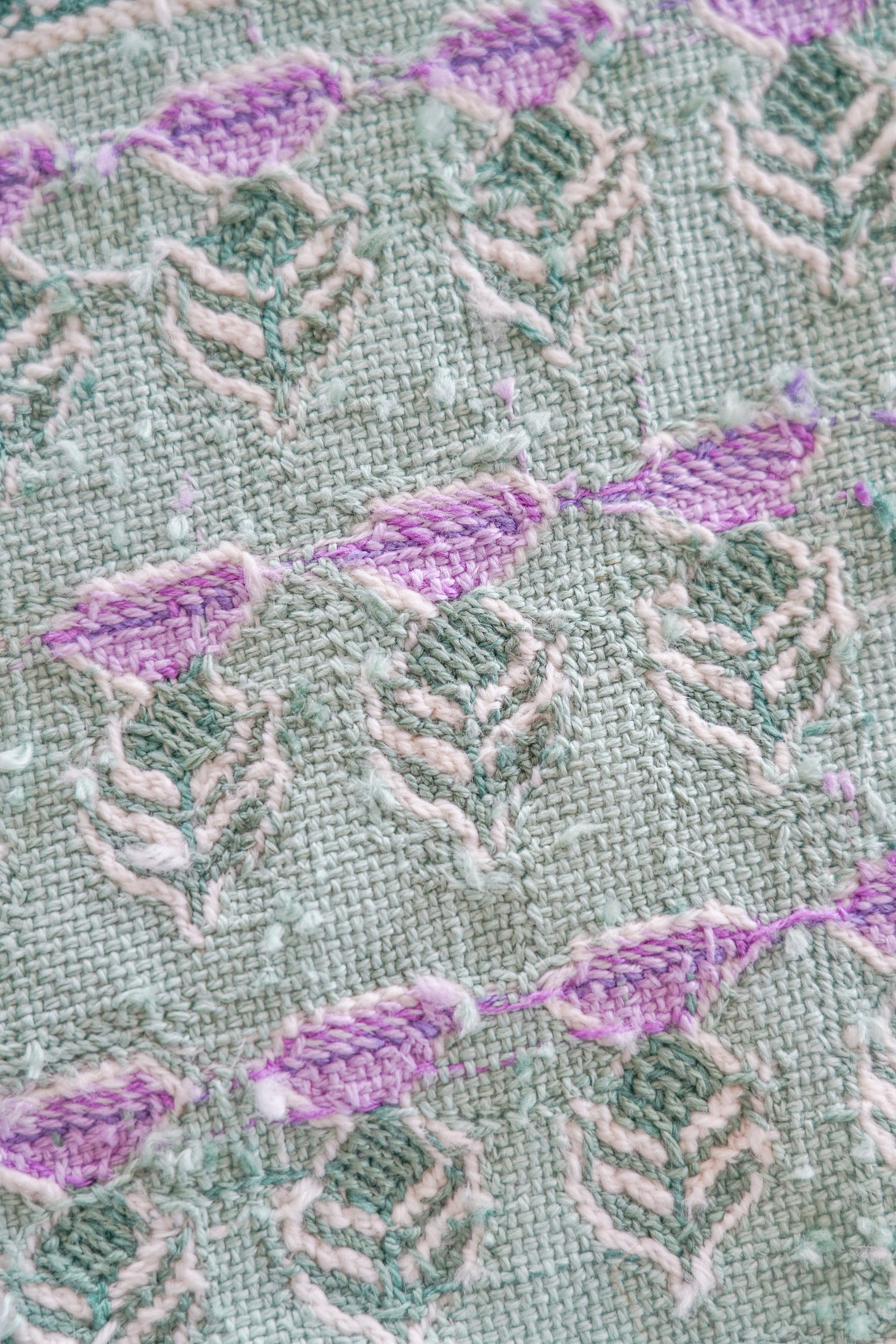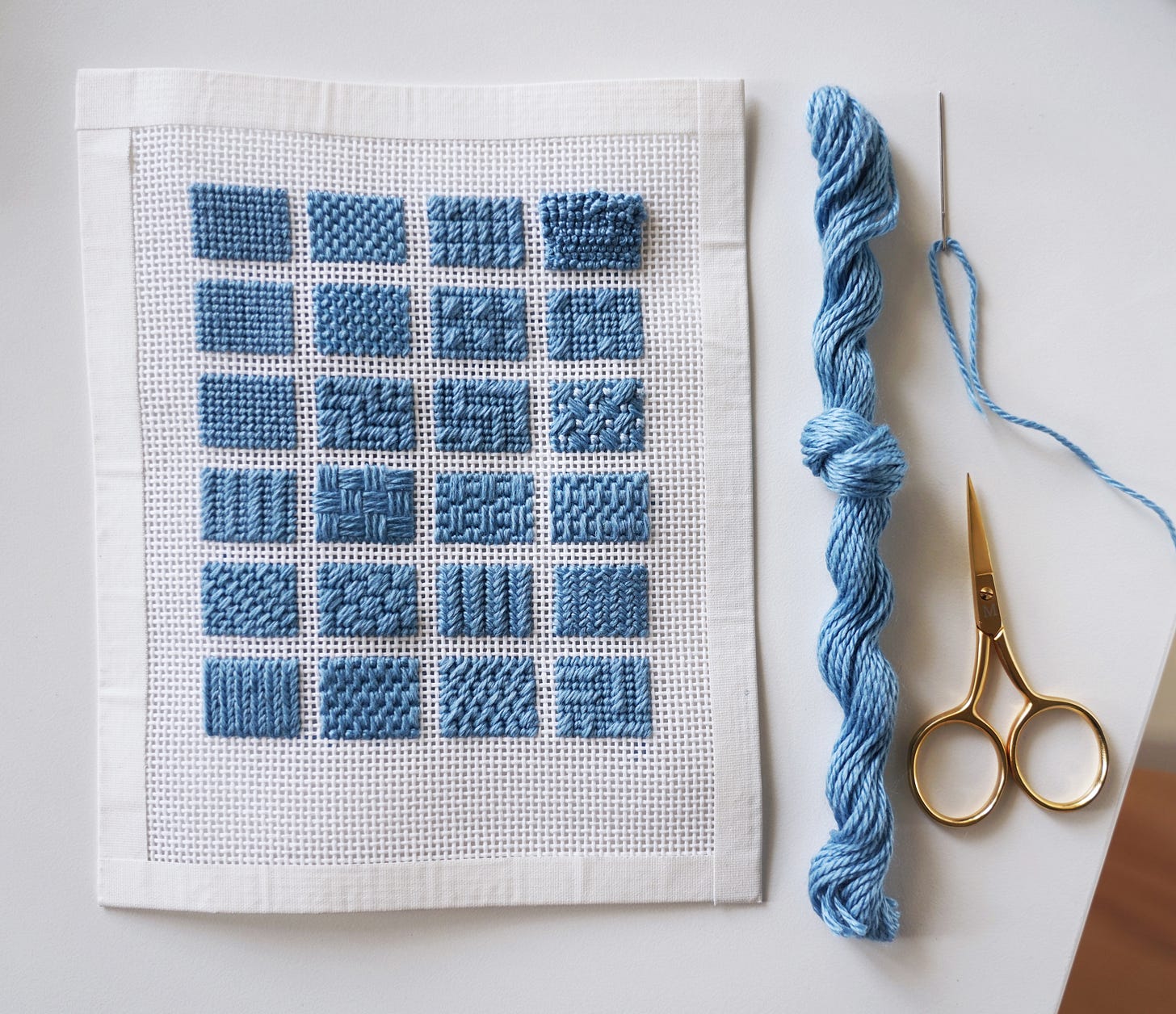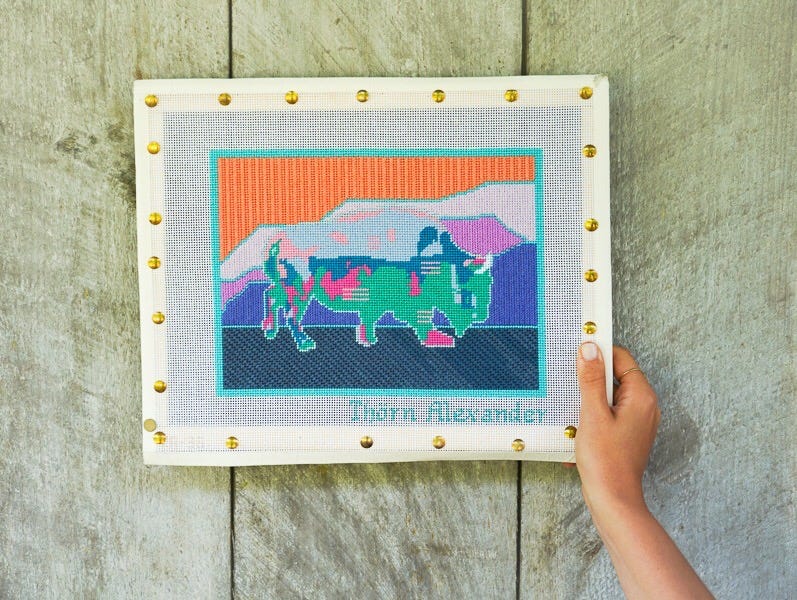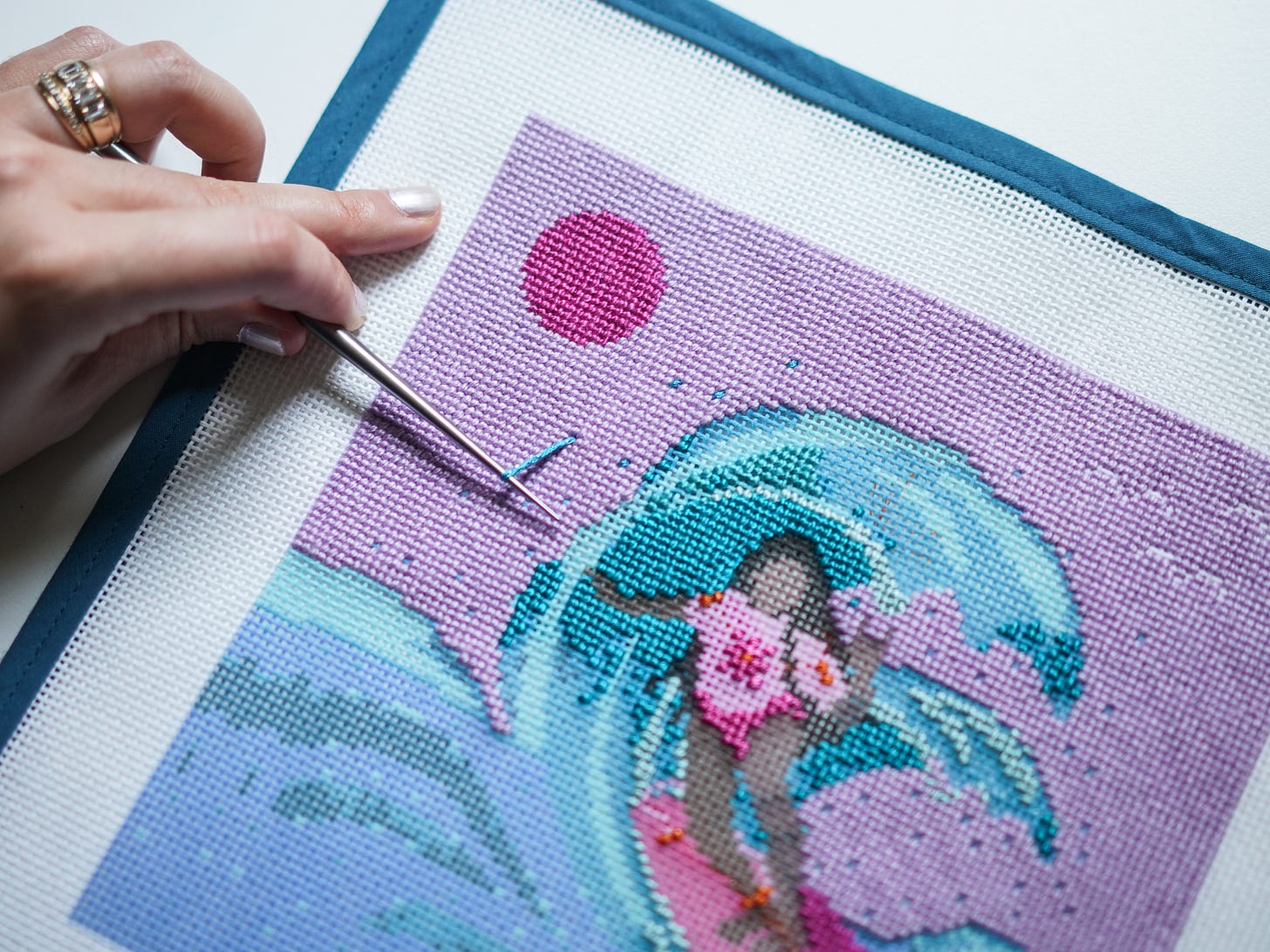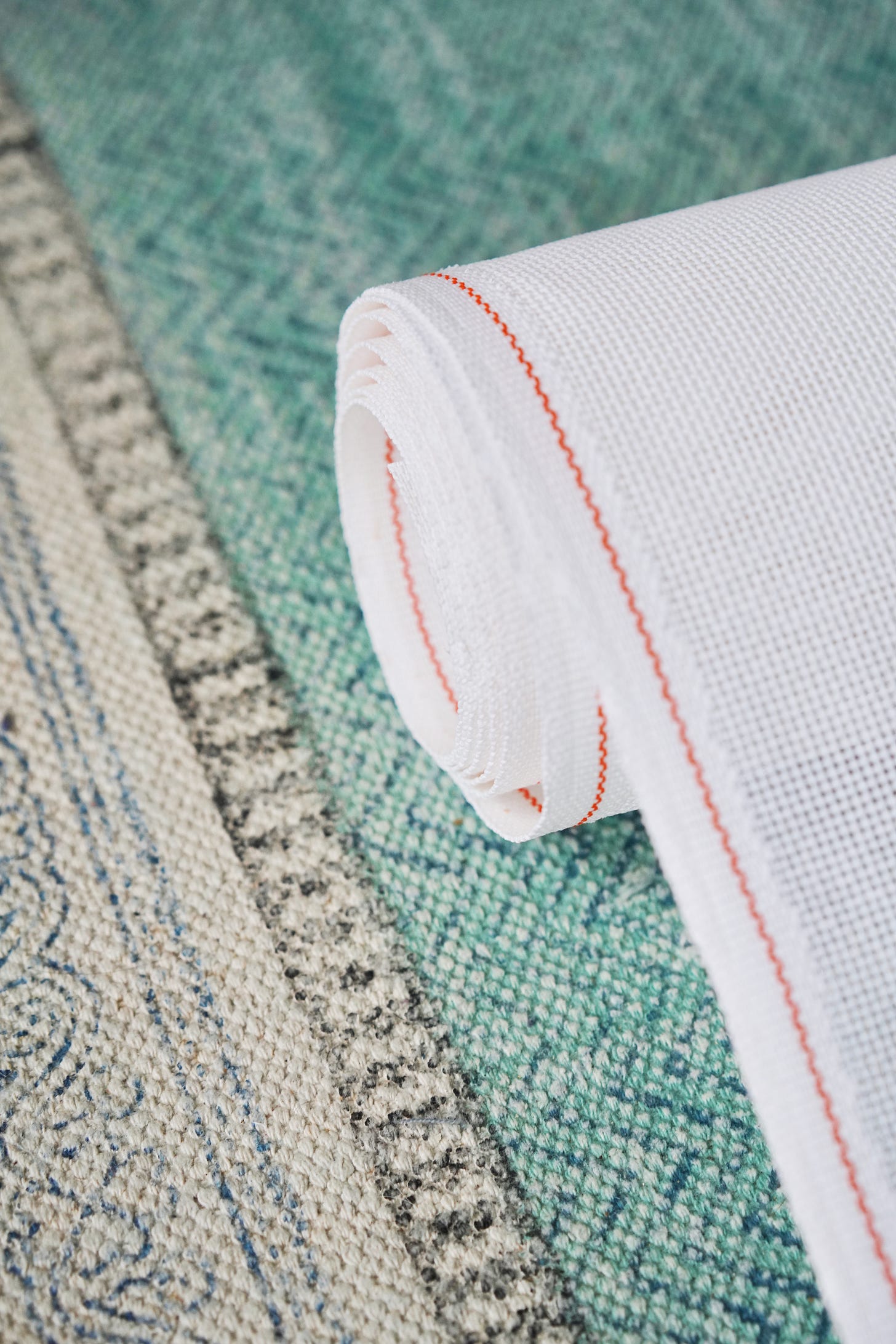Are you new to the world of needlepoint and feeling a bit overwhelmed by all the jargon? Fear not! In this post, we'll help you understand some of the most common terms used in the needlepoint community, so you can stitch with confidence. This post is a revised variation of my original post on my blog from April 2020.
Bargello: A technique that was particularly popular in the 1970s. By stitching your thread in upright stitches in a zig-zag formation, you can create a chevron-like pattern in a variety of colors. (You can also use continental stitch to emulate this concept.) This is a great way to use up your stash and can be done on a blank canvas for a relatively low cost.
Basketweave: A beginner stitch that results in a woven, basket-like appearance on the reverse side of your stitching. This is one of three basic "tent stitches."
Blocking: A process in which you dampen and pin a canvas face down on a "blocking board." This method allows you to realign your project if the stitching has caused your canvas to warp. Many needlepoint shops offer blocking and finishing services, but you can also learn to do it yourself.
Breakup Belt: A hilarious piece of needlepoint lore by which someone begins a needlepoint belt before marriage and the belt outlasts the relationship. I have succumbed to one break-up belt which wonderfully broke the curse for the one that now belongs to my now husband.
Canvas: A cotton weave that allows one to paint and stitch over it to create a handmade textile. The canvas often has a “sizing” or gesso that keeps it stiff and allows for painting without bleeding the color. The industry standard is made by a company called Zweigart in Germany. The gauge of the mesh weave is called mesh size. 13 mesh and 18 mesh are the most popular in the US while the UK tends to stitch on 10 mesh with chunkier wools.
Compensation: When using decorative stitches, you may run out of room to complete the stitch perfectly, especially around lettering or other motifs. Fill in the background stitches as best you can, then go back and create deliberate, shortened versions to make it appear as if you had been able to continue up to the cut-off point. When in doubt, use tent stitch.
Continental: Another beginner stitch that is worked either horizontally or vertically. It can be helpful in combination with other stitches to work around different shapes, fill in small sections, or compensate. This is another one of the three basic "tent stitches."
Decorative Stitches: By changing the slope of your stitch, you can add variety and texture to your projects! My favorites are brick, diagonal mosaic, corduroy and herringbone.
Dye Lot: A number that identifies each batch of fibers. If you think you might run out of a color, keep track of the dye lot number, as different batches may have slight color variations due to the way fibers bond to dye compounds.
Fibers: The material used for stitching, such as wool, silk, cotton, or synthetic threads. (I personally use the term “Threads” because, in my brain, a thread is made up of intertwined fibers).

Finishing: The process of transforming your completed needlepoint into a finished product, often carried out by a skilled "finisher" or seamstress. Most needlepoint shops can help you find the right finisher for your project. Different shops specialize in their own finishing styles. For stunning purple metallic leather, I would go to Lycette, for gorgeous acrylic finishes, I like Island House Needlepoint, and for everything else, I’m partial to KC Needlepoint— they finished my clutch above in gorgeous velvet.
Frogging or Ripping Out: The tedious but crucial task of removing stitches to correct colors, stitches, or techniques. Don't feel defeated if you have to frog your stitches; it's part of the process. In fact, I’m currently working up the courage do do so on my lavender scallop shell. Consider working on another project in between ripping out stitches to avoid frustration.
Frame or Stretcher Bars: Refers to a square or a rectangular frame. Frames keep the canvas taut, reduce the need for blocking, and allow the stitcher to use both hands while stitching. Some people prefer to pin the frame on top of the canvas, while others pin the canvas on top of the frame. One can use magnets or pins to keep it in place and a stand to make use of both hands. It is not necessary, but a great tool if you like decorative stitches or beading.
In-hand: Stitching without a frame, using your hands to hold the project. Stitchers often roll up the corners of their project to tackle different sections.
Interlock Canvas: A canvas with a double thread running in one direction and a single thread in the other, creating a grid of rectangles.
Laying Tool: A tool used to keep stitches lying smoothly and to prevent them from twisting.
"LNS": Short for Local Needlepoint Shop. There are over one hundred shops dedicated to needlepoint around the US and are a great resource to turn to for lessons, recommendations, kits, finishing, and more.
Mesh Size: The number of holes per linear inch in the canvas. Common mesh sizes include 10, 12, 13, 14, 18, and 24.
Mono Canvas: A canvas that has a single thread running in each direction, forming a grid of squares.
Needle Minder: A tool with two attracting magnets that hold your needles or small scissors in place, like the one pictured in the top left photograph of a Ginger Jar. Keep them away from electronics and credit cards.
Petit Point: A type of needlepoint done on Penelope canvas, which is like two layers of mesh interwoven. This allows for very small details in some parts and larger stitches in others, essentially enabling you to stitch in both 18 and 13 count on one canvas.
Ply: The number of strands that make up a thread. Threads can be single-ply or multiple-ply.
Printed canvas: While the technology is getting exceedingly better, printing does not always allow for the precise nature of stitch-painting. This certainly makes canvases affordable, it just requires a tiiiny bit of guesswork, but is no trouble at all.
Open stitches: A type of needlepoint stitch that doesn't completely cover the canvas, allowing the background to show through. These stitches create a more textured, lacy, or open appearance in contrast to the solid coverage provided by tent stitches. Open stitches are often used to add visual interest, create shading effects, or simulate the look of other textures like lace, netting, or foliage.
Ort: A short piece of thread that's left over after stitching. Some stitchers collect these in a jar or container as a memento of their projects.
Scooping: An old-school technique where the stitcher weaves the needle through the mesh, skipping the action of pulling the needle all the way down and then all the way up the weave. Instead, in one motion, you complete the stitch you're working on and start the next stitch simultaneously.
Selvage: The selvage is the finished edge of a woven fabric that runs parallel to the warp threads. For needlepoint canvas, this is the orange striped fabric. It is created by the weft threads looping around the outermost warp threads, creating a tightly bound edge that prevents the fabric from unraveling. The selvage is often more tightly woven and denser than the main body of the fabric, providing stability and a clean, finished edge. As a result, shops and designers typically keep the orange stripe on the left side of the canvas.
Skein: A unit of thread, several yards long, that has been wound and twisted for easy storage and can be easily unraveled and cut. The length from your middle finger to your shoulder is a good guideline for cutting thread, if not a tad shorter.
Stash: Your collection of threads and canvases!
Stitch Guide: A set of instructions that tells you which stitches and colors to use in each area of your design.
Stitch-painted canvas: This means the canvas has been meticulously painted so that each stitch is coordinated with a single color for ease of direction.
Stretcher Bars: Wooden bars used to stretch and secure your canvas, providing a taut surface for stitching.
Tapestry Needle: A blunt-tipped needle with a large eye, used for stitching on canvas.
Tent Stitch: The most basic needlepoint stitch, which includes basketweave, continental, and half-cross stitches.
Thread Palette: The selection of colors and textures of threads chosen for a particular project. I call them my “thread pairings!”
Warp: The warp refers to the threads that run lengthwise on a loom or in a woven fabric. These threads are held in tension on the loom and provide the foundation for the weft threads to be woven through. The warp threads are typically stronger and more tightly spun than the weft threads, as they bear the tension of the weaving process. The number of warp threads per inch determines the density and width of the fabric.
Waste Knot or Away Knot: A knot planted on top of the canvas when beginning a new project, strand, or section. This allows the stitcher to bind the tails in place without any mess or fuss.
Weft: The weft, also known as the fill or woof, refers to the threads that are woven horizontally across the warp threads. The weft threads are passed over and under the warp threads, creating the interlocking pattern that forms the fabric. The weft threads can be of various colors, textures, or materials, depending on the desired appearance and properties of the finished fabric.
WIPs: Work(s) in Progress.
Now that you've familiarized yourself with some of the most common needlepoint terms, you're ready to dive into your next project with confidence. If you have any other terms you have questions about or want to add to the list, feel free to do so in the comments!
Happy stitching!


